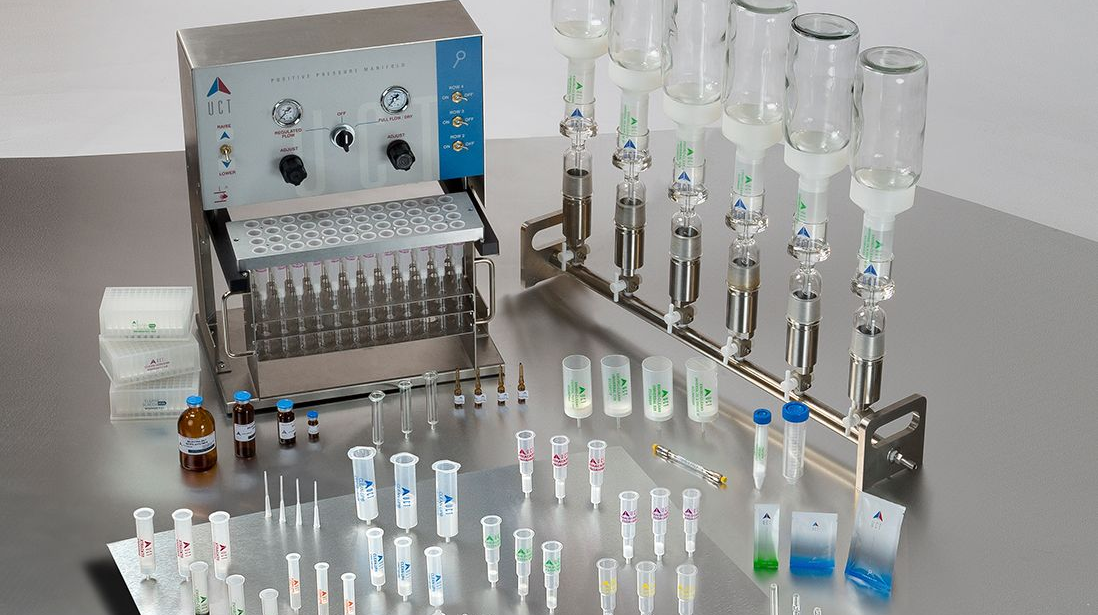Solid Phase Extraction Cartridges (SPE)
Solid Phase Extraction Columns
Want to know more
If you want to find out more about UCT range of SPE products, please get in touch with Chromatography Direct.
SPE cartridges are used in sample preparation techniques to extract target analytes from complex matrices. These cartridges contain sorbent materials that selectively retain analytes while allowing unwanted compounds to pass through. By utilising different sorbents and cartridge formats, SPE cartridges enable efficient purification and concentration of analytes, enhancing sensitivity and accuracy in subsequent analysis.
- Sorbent Chemistries: SPE cartridges employ a variety of sorbent chemistries to selectively retain target analytes while allowing unwanted compounds to pass through. The choice of sorbent chemistry depends on the nature of the analytes and the sample matrix. Reversed-phase sorbents, such as C18 or C8, are commonly used for nonpolar and moderately polar analytes, while normal-phase sorbents like silica are suitable for polar compounds. Ion-exchange sorbents also offer selectivity for charged analytes, while mixed-mode sorbents provide multiple retention mechanisms for complex separations.
- Sample Matrix Considerations: When selecting SPE cartridges, it is essential to consider the complexity and composition of the sample matrix. Different sample matrices may contain interfering compounds, contaminants, or high levels of impurities that can affect extraction efficiency. Understanding the sample matrix allows analysts to choose the appropriate sorbent chemistry and optimise the extraction method to achieve efficient purification and concentration of the target analytes.
- Cartridge Formats and Sizes: SPE cartridges are available in various formats, including traditional cartridges, disk plates, or microplates, providing flexibility to accommodate different sample volumes and throughput requirements. The choice of cartridge size depends on the sample volume and the concentration level of the target analytes. Selecting an appropriate cartridge format and size is important to ensure optimal sample loading and elution efficiency.
- Extraction Techniques: SPE cartridges can be used with different extraction techniques, such as gravity flow, vacuum, or positive pressure. Gravity flow is suitable for small-scale extractions, while vacuum or positive pressure methods are preferred for higher-throughput applications. Understanding the principles and limitations of each extraction technique helps choose the most appropriate method based on the sample volume, analyte characteristics, and laboratory resources.
- Sample Loading and Elution: Proper sample loading and elution techniques are crucial for achieving efficient extraction and recovery of target analytes. Factors such as sample pH, solvent compatibility, and sample flow rate must be considered during the loading step. Elution solvents and volumes should be optimised to ensure maximum recovery of the analytes of interest while minimising co-extraction of interfering substances. Employing suitable sample loading and elution strategies helps enhance extraction efficiency and analyte purity.
- Optimising Method Parameters: Developing an optimised SPE method involves evaluating and adjusting various parameters, including sample pH, solvent strength, flow rates, and washing steps. Analysts can achieve improved selectivity, higher analyte recovery, and lower matrix interference by systematically optimising these parameters. Method optimisation is essential to ensure reliable and reproducible results in subsequent analytical techniques.


